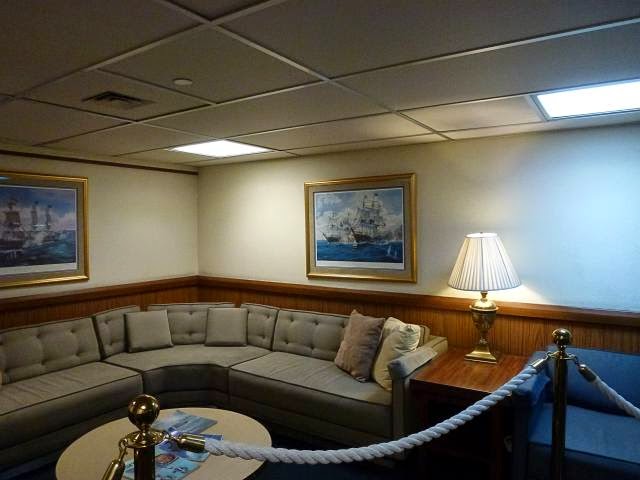The USS Midway is
an aircraft carrier. “She”, as all ships are referred to, was commissioned in
September 1945 and named after the WW2 battle of Midway Island in 1942 where
the US navy decisively defeated the Japanese. The Midway was retired in 1992
and became a floating museum in 2004.
Here she is- the
vessel that is, rather than the dubious looking ‘hello sailor’ type on the
sidewalk. And we’ve no time see him perform the hornpipe today; let’s go
aboard.
The entrance leads
into the hanger deck. It’s huge and seems to run almost the full length and breadth
of the ship. Here there are examples of the first aircraft that used the carrier,
piston engine WW2 types. This is where we also picked up our audio guides that
came included in the very reasonable entrance price.
Following the
numbered guide, we proceeded into the ordinary crewmen’s quarters. These looked
cramped, to say the least, even though she was the biggest ship in the world for
her first 10 years, but a crew of 4,500 takes some accommodating. You’ll note
they are triple bunks, with lockers in the middle. There’s hardly room for the
traditional pin-ups.
One doesn’t give
much thought to crew discipline but with 4,500 vigorous males living in close
proximity there have to be in issues. The most severe penalty was prison,
called the brig in navy parlance, where offenders would be locked up by order
of the captain. There were individual cells and a communal cell, which is the
one shown in the photo. The layout of the cell bunks actually gives the
prisoners more space than the law abiding seamen when you compare it with
the previous photo!
Men are fascinated by big machinery. So I’m transfixed by
the anchor chains, 2,000 ft. long and attached to 20 ton anchors. Apparently
the noise of the rattling chains was deafening when the anchors were dropped.
Good food was provided
for all ranks: self-service for crewmen, and in impressive elegance for the
officers. Notice the silver service in the glass cabinet that would have been
used for formal occasions. No salt beef and hard tack biscuits for these guys.
The whole purpose
of the ship was to provide air strike capability. To that end, some 200 pilots
were available to fly the assorted complement of 70 or so planes and
helicopters. In the Vietnam War they might have flown this Skyhawk, currently
patrolling over the café area.
The Midway was in
service for 47 years, with several major refits along the way. It started as a
45,000 ton ship and ended weighing 69,000 tons. One of the ex-navy guides on
the ship said that she ended up being top heavy. I wonder if the captain had to
sometimes announce, “Sorry lads, bit of a swell today, so we’ll not be leaving
port. We can’t risk capsizing.”
The ship always carried
top of the range strike aircraft of the day, finishing with the 1,500 mile per
hour Tomcat fighter that featured in the movie Top Gun.
This is the communications room where intelligence was received and
messages sent. It looks old fashioned now and probably all of it would fit in a
modern laptop computer. This was the nerve centre of the ship as you will have
guessed from the nervous figure in the background.
The Operations Room
shows the original maps used in planning the first Gulf War. The Midway was the
command centre for the military task force so contained an admiral as well as a
ship’s captain.
The admiral and
captain occupied similar private accommodation aboard, well up to best hotel
standards. They were the only personnel to sleep in ordinary beds. The
Admiral’s lounge gives an idea of the sort of comfort afforded.
There were many
more areas on the audio tour e.g. kitchens, operating theatre, dentists,
laundry, engine room, chapel, briefing
rooms and so on, all well laid out and described. It was a full and fascinating
day out and a tribute to its creators and to those who now operate the Midway
Museum.












No comments:
Post a Comment